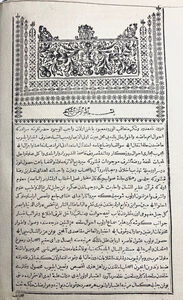AHMED VASIF

Mehâsinü’l-Âsâr ve Hakaikü’l-Ahbâr (The Charms and Truths of Relics and Annals)
Printed in Ottoman Turkish
Cairo: Bulaq, 1246 [1830] ÖZEGE 225192
2 Volums in 1 Vol., I: 14, 210 p.; II: 7, 190 pp. (The first 2 folios of the index of vol. 1 are damaged and some text is missing. A photocopy with the full text has been inserted)
Half-leather bound, 28 x 18 cm.
Order No.: RAR_126
Status: available
Price: 2 100 € (excl. VAT)
Add to Shopping Cart
Click for further details
“The Chronicler Ahmed Vâsıf on Agency, Causality, and a Reformist Philosophy of History”18th century Ottoman court chronicles are rarely studied as products of active, inquisitive minds. Most often they are seen as factual records without larger aims or messages. Such an approach, it should be s aid, obscures the chronicler's role in bringing his own sense and form to history. This paper will explore some ways in which one prominent Ottoman historian came to terms with the past, above all the strange and inexplicable. Ahmed Vâsıf Efendi published his history Mehâsinü’l–Âsâr ve Hakaikü’l–Ahbâr (The Charms and Truths of Relics and Annals) in 1804. As a court chronicler (vakanüvis) he was charged with recording events of the court: war, administration, diplomacy, and ceremony. Yet Vâsıf undertook much more in Mehâsin, an interpretive digest of four earlier court chronicles. Mehâsin shows a mind seeking order, unity, and meaning in events of the past. I will focus primarily on how Vâsıf makes sense of strange or unexpected events, including premonitions, fires, earthquakes, eclipses, meteorites, and other natural phenomena. His reaction is far from that of a neutral recorder. Vâsıf often uses these moments to edify: he ties them, explicitly or implicitly, to individual action or a moral order embodied in the ruler. At other times, they bear more “rational” explanation. Vâsıf's interpretations, however, uphold in all cases a strongly colored view of the past and moralistic function of history. The sampling offered in this paper is admittedly small. Still, it is enough to prompt further questions about the court chronicler's function and, more generally, about Ottoman conceptions of history and the natural world in the 18th century. At the very least it will encourage us to read more closely. (Ethan Menchinger, University of Michigan)



